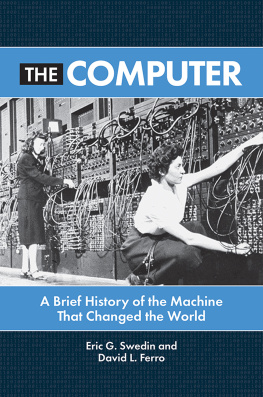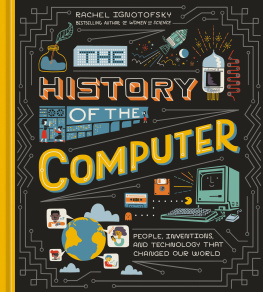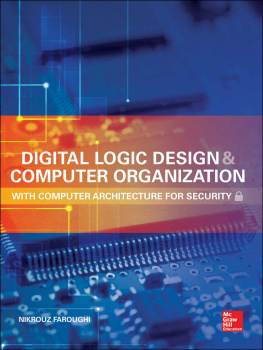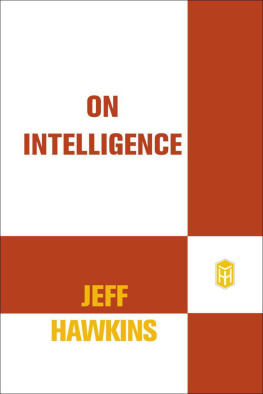FOREWORD
AUTHOR: DAG SPICER
What computers mean to us depends largely on what we bring to them. Our expectations, our past experience, the dreams and myths that surround them, their physical characteristicsall these aspects resonate on multiple, often overlapping levels.
One level is aesthetic. Many nonspecialists in the computer arts enjoy these machines for their visual appeal and curiosity. Nearly everyone, regardless of technical background, can appreciate the intricacies of a computers mechanical design, its rows of switches and blinking lights, its often ungainly proportions, and the personal connection they feel when they recognize the first computer they used.
A second level is important for specialists. People trained in computer science or electrical engineering bring the additional dimension of how these objects illuminate abstract principles of computer architecture and the ideas immanent in their designideas that give us insight into the minds of their designers and the challenges they faced.
A third level is the historical trajectory of these objects: how they were financed and why, what problems they were trying to solve, and the mistakes made and dead ends encountered by their designers. We learn a lot by understanding these human elements and how they shaped historical and technical factors into stable artifacts, in turn stitching together the fabric of todays information-based society.
Each of these three levels can be applied to all artifacts of human culture, from the earliest bone tools of Australopithecus more than two million years ago to the most advanced modern operating systems of today. With time, items with complex overlapping levels of interpretation like these can eventually collapse into hermetic objects, or black boxes. For this reason, curators and museums, through their exhibitions and programs, are necessary. Without them, there isnt direct communication with the viewer, no mechanism for teasing out these levels. Without them, there is no longer an understanding of how something was developedonly the object itself, uninterpreted, or, conversely, only secondary sources and no object, like Hamlet without the Prince.
The Computer History Museum is home to the worlds largest collection of computer artifacts and serves as a way station for us to catch our collective breath by opening these black boxes. It does this by paying attention to the three interpretive levels described above. The museum carefully preserves the artifacts themselves (aesthetic); explains their technologies and context (technological); and relates how they came into and, ultimately, out of being (historical).
Mark Richardss wonderful photographs capture the fascinating machines in the museums collection from a hyperaesthetic viewpoint, while John Aldermans text speaks to their unique historical context. The period covered in this book spans from the first giant machinessuch as the room-filling ENIACto very recent personal computers.
Today, the compaction of transistors into ever smaller spaces has made available to almost anyone the computer power that formerly was the preserve of well-funded institutions. This has, in turn, transformed computers from number crunchers into generic platforms for visualization, entertainment, and communication, mediating almost all of our interactions with the modern world. Billions of computations and logical operations still take place every second inside the black box, but the fraction of computers used as supercalculators gets smaller with every Tivo, iPod, cellular phone, and car sold. It is information, not only mathematical results, that is produced, exchanged, and transformed, becoming the very lifeblood of the twenty-first century as oil was in the twentieth and steam was in the nineteenth.
How do we make sense of all this?
With historians still debating the impact of the French Revolution more than two hundred years ago, it seems unlikely that we shall be able to digest fully the impact of the computerbarely fifty years oldfor a long time to come. We are simply too embedded in its history, and it in usfrom the moment we are born to our last breath. But we should still try. Reflecting on computers as visual milestones, as this book enables us to do, allows us to step back and appreciate them in a different context, one with a deep and rich history, rather than as objects isolated in time with no connection to what has gone before them.
Computers, like all artifacts, are made by people and reflect their strengths and weaknesses, their brilliance and their follies. I hope that as you enjoy this book, and the unique interpretive lens of Mark Richards and the essays by John Alderman, you will discover computers as objects of beauty that also mirror the human condition in all its richness, struggle, and creativity.
DAG SPICER
SENIOR CURATOR
COMPUTER HISTORY MUSEUM, MOUNTAIN VIEW, CALIFORNIA
| NAME |
| YEAR CREATED | 1941 (RECONSTRUCTED 1999) |
| CREATOR | RAUL ROJAS/KONRAD ZUSE |
| MEMORY | 64 WORDS |
In the midst of World War II, the worlds first programmable, automatic electromagnetic computer was built by a German, civil engineer Konrad Zuse. Surprisingly, though it was presented to fellow German scientists, not much was made of it at the time, and it was destroyed in 1944 during an Allied bombing raid on Berlin. This is a re-imagining (for teaching purposes) of the adder unit of that destroyed machine, which used twenty-four hundred telephone relays as switches for memory, instead of vacuum tubes, and hole-punched movie film as a storage medium.
Zuse had been called up for military service but convinced the recruiters that he was better used creating computers, and one of his machines was used to produce glide bombs. Despite that brush with the army, Zuse received very little war funding, and his work was not widely known. Some speculate that the Z3 would have been much more significant without the warespecially since the Allied competition was driven so heavily by military investment.
After the war, in 1946, IBM optioned Zuses patents. Zuse used that money to start his own computer company, the Zuse-Ingenieurbro Hopferau (changed to Zuse KG in 1949), which successfully built many other computers and was finally bought by Siemens in 1967.



| NAME |
| YEAR CREATED | 1946 |
| CREATOR | U.S. ARMY AND MOORE SCHOOL OF ENGINEERING, UNIVERSITY OF PENNSYLVANIA |
| COST | APPROX. $500,000 |
| MEMORY | 20 TEN-DIGIT NUMBERS |
Though it was finished in early 1946 after Nagasakis mushroom cloud ended the fightingthe Electronic Numerica l Integrator and Computer, ENIAC, was a product of World War II and that conflicts creation of a desperate, ever-spiraling drive to outdo the opponent technologically. While the Manhattan Project feverishly completed work on the atom bomb, another effort at the University of Pennsylvanias Moore School of Engineering brought together young electrical engineer J. Presper Eckert, physicist John Mauchly, U.S. Army Captain and ballistics expert Herman H. Goldstine, and, later, the renowned mathematician John von Neumann to create a fantastic machine of forty separate eight-foot-high racks, eighteen thousand tubes, and more, at a cost of about five hundred thousand dollars.










